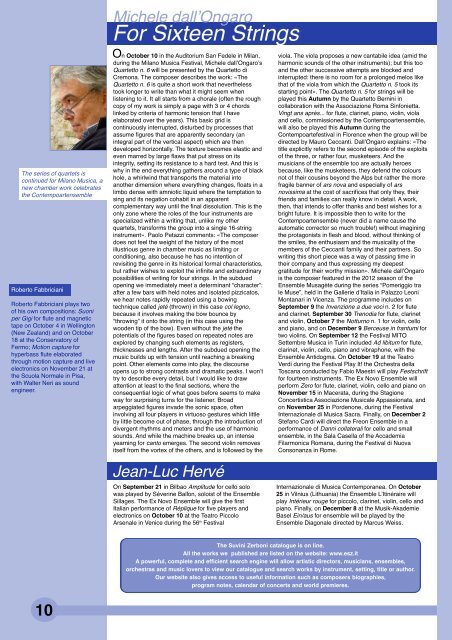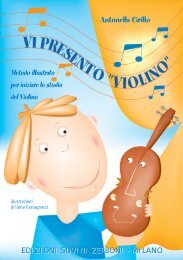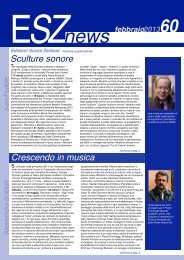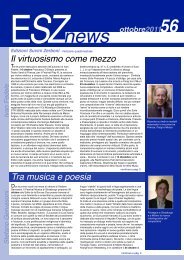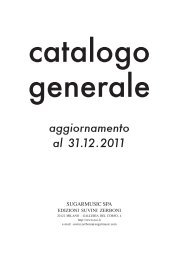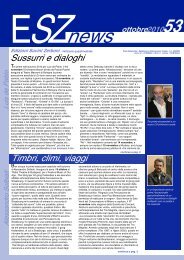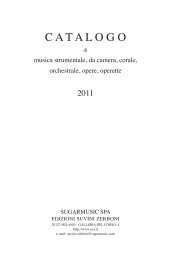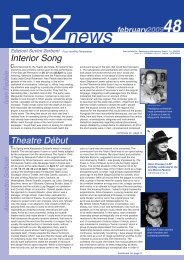Timbral Spaces Sound Labyrinths - Edizioni Suvini Zerboni
Timbral Spaces Sound Labyrinths - Edizioni Suvini Zerboni
Timbral Spaces Sound Labyrinths - Edizioni Suvini Zerboni
Create successful ePaper yourself
Turn your PDF publications into a flip-book with our unique Google optimized e-Paper software.
The series of quartets is<br />
continued for Milano Musica, a<br />
new chamber work celebrates<br />
the Contempoartensemble<br />
Roberto Fabbriciani<br />
Roberto Fabbriciani plays two<br />
of his own compositions: Suoni<br />
per Gigi for flute and magnetic<br />
tape on October 4 in Wellington<br />
(New Zealand) and on October<br />
18 at the Conservatory of<br />
Fermo; Motion capture for<br />
hyperbass flute elaborated<br />
through motion capture and live<br />
electronics on November 21 at<br />
the Scuola Normale in Pisa,<br />
with Walter Neri as sound<br />
engineer.<br />
10<br />
Michele dall’Ongaro<br />
For Sixteen Strings<br />
O<br />
n October 10 in the Auditorium San Fedele in Milan,<br />
during the Milano Musica Festival, Michele dall’Ongaro’s<br />
Quartetto n. 6 will be presented by the Quartetto di<br />
Cremona. The composer describes the work: «The<br />
Quartetto n. 6 is quite a short work that nevertheless<br />
took longer to write than what it might seem when<br />
listening to it. It all starts from a chorale (often the rough<br />
copy of my work is simply a page with 3 or 4 chords<br />
linked by criteria of harmonic tension that I have<br />
elaborated over the years). This basic grid is<br />
continuously interrupted, disturbed by processes that<br />
assume figures that are apparently secondary (an<br />
integral part of the vertical aspect) which are then<br />
developed horizontally. The texture becomes elastic and<br />
even marred by large flaws that put stress on its<br />
integrity, setting its resistance to a hard test. And this is<br />
why in the end everything gathers around a type of black<br />
hole, a whirlwind that transports the material into<br />
another dimension where everything changes, floats in a<br />
limbo dense with amniotic liquid where the temptation to<br />
sing and its negation cohabit in an apparent<br />
complementary way until the final dissolution. This is the<br />
only zone where the roles of the four instruments are<br />
specialized within a writing that, unlike my other<br />
quartets, transforms the group into a single 16-string<br />
instrument». Paolo Petazzi comments: «The composer<br />
does not feel the weight of the history of the most<br />
illustrious genre in chamber music as limiting or<br />
conditioning, also because he has no intention of<br />
revisiting the genre in its historical formal characteristics,<br />
but rather wishes to exploit the infinite and extraordinary<br />
possibilities of writing for four strings. In the subdued<br />
opening we immediately meet a determinant “character”:<br />
after a few bars with held notes and isolated pizzicatos,<br />
we hear notes rapidly repeated using a bowing<br />
technique called jeté (thrown) in this case col legno,<br />
because it involves making the bow bounce by<br />
“throwing” it onto the string (in this case using the<br />
wooden tip of the bow). Even without the jeté the<br />
potentials of the figures based on repeated notes are<br />
explored by changing such elements as registers,<br />
thicknesses and lengths. After the subdued opening the<br />
music builds up with tension until reaching a breaking<br />
point. Other elements come into play, the discourse<br />
opens up to strong contrasts and dramatic peaks. I won’t<br />
try to describe every detail, but I would like to draw<br />
attention at least to the final sections, where the<br />
consequential logic of what goes before seems to make<br />
way for surprising turns for the listener. Broad<br />
arpeggiated figures invade the sonic space, often<br />
involving all four players in virtuoso gestures which little<br />
by little become out of phase, through the introduction of<br />
divergent rhythms and meters and the use of harmonic<br />
sounds. And while the machine breaks up, an intense<br />
yearning for canto emerges. The second violin removes<br />
itself from the vortex of the others, and is followed by the<br />
Jean-Luc Hervé<br />
On September 21 in Bilbao Amplitude for cello solo<br />
was played by Séverine Ballon, soloist of the Ensemble<br />
Sillages. The Ex Novo Ensemble will give the first<br />
Italian performance of Réplique for five players and<br />
electronics on October 10 at the Teatro Piccolo<br />
Arsenale in Venice during the 56 th Festival<br />
viola. The viola proposes a new cantabile idea (amid the<br />
harmonic sounds of the other instruments); but this too<br />
and the other successive attempts are blocked and<br />
interrupted: there is no room for a prolonged melos like<br />
that of the viola from which the Quartetto n. 5 took its<br />
starting point». The Quartetto n. 5 for strings will be<br />
played this Autumn by the Quartetto Bernini in<br />
collaboration with the Associazione Roma Sinfonietta.<br />
Vingt ans après... for flute, clarinet, piano, violin, viola<br />
and cello, commissioned by the Contempoartensemble,<br />
will also be played this Autumn during the<br />
Contempoartefestival in Florence when the group will be<br />
directed by Mauro Ceccanti. Dall’Ongaro explains: «The<br />
title explicitly refers to the second episode of the exploits<br />
of the three, or rather four, musketeers. And the<br />
musicians of the ensemble too are actually heroes<br />
because, like the musketeers, they defend the colours<br />
not of their cousins beyond the Alps but rather the more<br />
fragile banner of ars nova and especially of ars<br />
novissima at the cost of sacrifices that only they, their<br />
friends and families can really know in detail. A work,<br />
then, that intends to offer thanks and best wishes for a<br />
bright future. It is impossible then to write for the<br />
Contempoartensemble (never did a name cause the<br />
automatic corrector so much trouble!) without imagining<br />
the protagonists in flesh and blood, without thinking of<br />
the smiles, the enthusiasm and the musicality of the<br />
members of the Ceccanti family and their partners. So<br />
writing this short piece was a way of passing time in<br />
their company and thus expressing my deepest<br />
gratitude for their worthy mission». Michele dall’Ongaro<br />
is the composer featured in the 2012 season of the<br />
Ensemble Musagète during the series “Pomeriggio tra<br />
le Muse”, held in the Gallerie d’Italia in Palazzo Leoni<br />
Montanari in Vicenza. The programme includes on<br />
September 9 the Invenzione a due voci n. 2 for flute<br />
and clarinet, September 30 Trenodia for flute, clarinet<br />
and violin, October 7 the Notturno n. 1 for violin, cello<br />
and piano, and on December 9 Berceuse in frantumi for<br />
two violins. On September 12 the Festival MITO<br />
Settembre Musica in Turin included Ad libitum for flute,<br />
clarinet, violin, cello, piano and vibraphone, with the<br />
Ensemble Antidogma. On October 19 at the Teatro<br />
Verdi during the Festival Play It! the Orchestra della<br />
Toscana conducted by Fabio Maestri will play Festschrift<br />
for fourteen instruments. The Ex Novo Ensemble will<br />
perform Zero for flute, clarinet, violin, cello and piano on<br />
November 15 in Macerata, during the Stagione<br />
Concertistica Associazione Musicale Appassionata, and<br />
on November 25 in Pordenone, during the Festival<br />
Internazionale di Musica Sacra. Finally, on December 2<br />
Stefano Cardi will direct the Freon Ensemble in a<br />
performance of Danni collaterali for cello and small<br />
ensemble, in the Sala Casella of the Accademia<br />
Filarmonica Romana, during the Festival di Nuova<br />
Consonanza in Rome.<br />
Internazionale di Musica Contemporanea. On October<br />
25 in Vilnius (Lithuania) the Ensemble L’Itinéraire will<br />
play Intérieur rouge for piccolo, clarinet, violin, cello and<br />
piano. Finally, on December 8 at the Musik-Akademie<br />
Basel Ein/aus for ensemble will be played by the<br />
Ensemble Diagonale directed by Marcus Weiss.<br />
The <strong>Suvini</strong> <strong>Zerboni</strong> catalogue is on line.<br />
All the works we published are listed on the website: www.esz.it<br />
A powerful, complete and efficient search engine will allow artistic directors, musicians, ensembles,<br />
orchestras and music lovers to view our catalogue and search works by instrument, setting, title or author.<br />
Our website also gives access to useful information such as composers biographies,<br />
program notes, calendar of concerts and world premieres.


